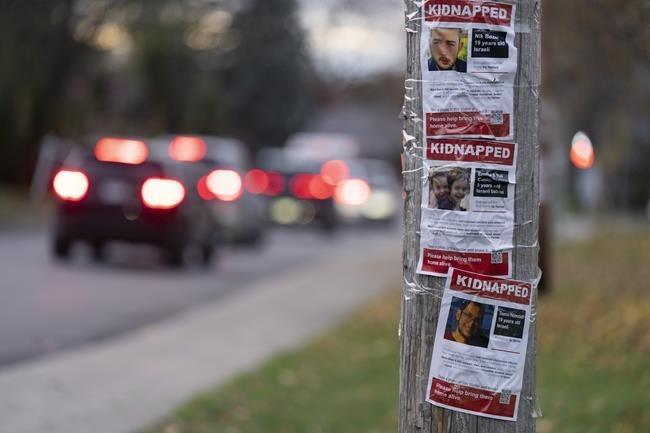MONTREAL — In Montreal, symbols of the war between Israel and Hamas are everywhere. Jarring signs and graffiti demonstrating support for the Israeli or Palestinian causes have become part of the cityscape: on sidewalks, lamp posts and bus shelters.
The rivalry between pro-Israel and pro-Palestinian camps is unfolding as a visual competition not only in Montreal but across North America, raising questions about the role these images are playing in escalating local tensions tied to the distant conflict.
And the intensity of that rivalry distinguishes it from other cultural and political disputes in recent history, says Aidan McGarry, an international politics professor at Loughborough University, in England, who studies visual elements in protest movements.
Protests spur counter-protest movements, he explained in an interview. Often, he said, those counter-protests manifest in more subdued or latent messaging.
"What's different this time is that you have two groups that are absolutely vying for the public's attention," he said. "They want the public on their side and they both completely believe they are … in the right."
Solidarity for Palestinian Human Rights (SPHR) McGill is one of the organizations that advocates for what it calls "resistance through expression." In addition to demonstrations, the McGill University student group has organized banner and poster-making activities.
SPHR McGill organizer John Vogel, who has designed some of the group's posters and social media graphics, says it's deploying visual media to "hold control of the popular narrative" and challenge pro-Israel discourses. He credits that work for helping to drive what he says has been "an unprecedented amount of student support on campus" for the Palestinian cause.
"Visual, eye-catching work," Vogel said in an interview, is "the main front on which we're able to … fight for a narrative that supports Palestinian liberation."
Shaping narratives is often the goal of protest movement communication strategies, McGarry said. Visual markers can also be a way for protesters to "assert belonging" in public spaces and extend messages of sympathy and solidarity with Israelis and Palestinians, he added.
These symbols can elicit emotional responses in onlookers, McGarry said. Images of victims or destruction, for example, "(confront) people with the reality of something that has happened very far away. And then, the public is left with this … strong reaction."
It's also possible, he said, that such responses can help stimulate the kind of enmity that leads to violence.
Montreal has seen a surge of acts targeting the Jewish and Muslim communities since the outbreak of the Israel-Hamas war last month. Police are investigating multiple incidents of overnight gunshots hitting Jewish schools, as well as firebombings that caused minor damage to the exterior of two Jewish institutions. There were no injuries in any of those cases.
The National Council of Canadian Muslims says it has also received reports of racist graffiti and assaults on Muslim Montrealers, including several cases in which assailants ripped off women's hijabs.
Local Jewish and Muslim community leaders have described an atmosphere of fear and anxiety. And in Montreal and elsewhere, visuals linked to the Israel-Hamas war have at times stirred fierce responses and debate.
When 16 metro stations were plastered earlier this week with pro-Palestinian posters reading, "genocide in Palestine, Canada complicit," the Montreal police department initially assigned its hate crimes squad to investigate but later transferred the matter to the police unit that patrols the metro system.
On Thursday morning, Montreal police responded to a pro-Palestinian demonstration that blocked traffic on the Jacques Cartier Bridge, which crosses the St. Lawrence River. Social media images show demonstrators holding large banners calling for a "free Palestine" and ceasefire in Gaza.
News reports from several cities recount the proliferation — and subsequent shredding — of posters depicting the roughly 240 hostages that Hamas captured during its Oct. 7 attack on Israel. The red-and-white posters have become one of the most recognizable signs of the Israeli cause.
Incidents in which individuals have removed the posters led officials in the Montreal suburb of Hampstead to propose a bylaw that would label acts of sign removal from public property a nuisance and impose a $1,000 fine for a first offence and a $2,000 fine for repeat offences.
Yair Szlak, president and CEO of Montreal Jewish advocacy organization Federation CJA, said the tearing down of hostage posters amounts to "cancelling" human beings. "Jewish life is not important enough," Szlak said in an interview. "There are people who will tear down posters in the most cruel act of cancelling somebody, meaning that life is not important."
"I don't see this (as) advocacy for Israel," he said of the posters. "This is what I would call advocacy for humanity."
Szlak said narratives that entirely blame Israel for the death of civilians in the Gaza Strip without acknowledging the actions of Hamas incite antisemitic violence.
Vogel asserted that "pro-Palestinian art or expression only escalates tensions in that it forces people to address the Palestinian cause in their daily lives."
McGarry described the competition between pro-Israel and pro-Palestinian demonstrations as "a battle to win the hearts and minds of different sections of society."
"Usually when you have a protest manifestation, it's on one side or the other. And here you have both sides quite strong," he said. "I've never seen it like this before."
This report by The Canadian Press was first published Nov. 16, 2023.
Thomas MacDonald, The Canadian Press




